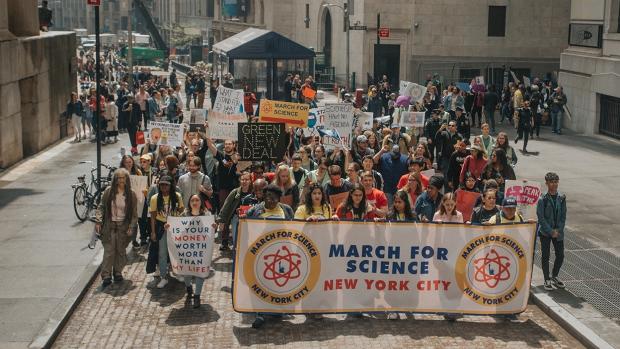Marching for science
Tandon students take to the streets to advocate for science

In early 2017 Ingrid Paredes, now a doctoral candidate in the Department of Chemical and Biomolecular Engineering, was excited to see a Facebook posting announcing the inaugural March for Science, an event scheduled to take place in April of that year in Washington, DC. Activists would rally to demand funding for research and advocate for the importance of robust science. Omar Gowayed, a fellow Ph.D. student, was equally excited, and soon their enthusiasm had infected others: thanks in large part to their efforts, NYU became the first academic institution to partner with the March for Science organization.
Since then, the single-day event has evolved into a global movement calling for robustly funded and publicly communicated science as a pillar of human freedom and prosperity, and Paredes and Gowayed have become New York City organizers for the group, working to establish a local network of active scientists — including many from Tandon.
The 2019 march was held in early May, with the theme of “Educate to Empower.” A chief goal was to motivate members of the public to understand how science can advance the common good and to get them involved in advocacy. Gowayed explained, “Using scientific evidence as our tool, we, the people, can truly affect change no matter how impossible it seems!"
At the event, Paredes introduced herself — and her mission — to the crowd, saying, “I am a scientist for a Green New Deal, legislation centered on people and justice. We must ensure that people and justice are at the center of our science, too. To get there, we need diversity in STEM. We need inclusion in STEM. We need equity in STEM. We need to stand up for those who have been wrongly told that science does not belong to them. For the LGBTQ community. For people of color. For women like myself."
In addition to New York, marches were held at some 100 other locations worldwide, with speakers touching upon issues ranging from climate change and a Green New Deal to sexual harassment, gender inequity, and activism within STEM.
Paredes — who has expressed gratitude for Tandon’s support of the initiative, which this year included $5,000 in funding — says that the organization’s activities extend well beyond the marches themselves. “We’ve fought the graduate student tax, and we’ve registered voters,” she said. “We’ve talked to the public about the intersection of science and policy. We’ve elected scientists into congress. Our work has only just begun, and the march is only one element of what we do.”
Major pillars of the March for Science
- Open access of scientific information to the general public
- Use of science for the common good and in the preservation of an informed democracy
- Protection of human and environmental rights




